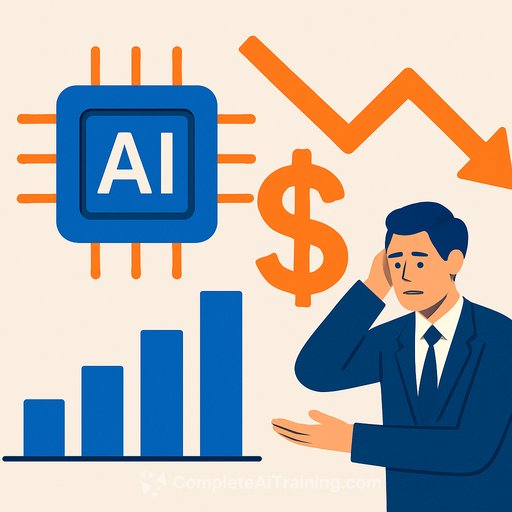Tech's AI debt surge is cooling the market - here's what finance teams should watch
AI is moving from "funded by profits" to "funded by bonds." Hyperscalers need more data centers, power, and chips - and the tab is too big for cash flow alone. Investors are waking up to the risk: spreads are widening, CDS is climbing, and the market's easy love for tech is fading.
The fastest tell: Oracle. It's now the most indebted investment-grade tech name, tied closely to OpenAI, and staring at a potential downgrade. This isn't idiosyncratic - it's a preview of a credit cycle shaped by AI capex.
The bill for AI: massive, front-loaded, and debt-heavy
- J.P. Morgan pegs total AI/data center and power infrastructure needs at $5T+ by 2030. Only ~$1.5T is covered by organic cash flow.
- The big five with AI exposure - Alphabet, Amazon, Microsoft, Meta, Oracle - may issue ~$1.5T in bonds over five years, with ~$300B in 2026 alone.
- If that plays out, AI/data center-linked credit could exceed 20% of the market by 2030.
Supply is already hitting. From September to October, tech names raised ~$75B in IG bonds. Full-year issuance is on track to top $200B, funding roughly $380B of AI-related build-out.
Oracle: the market's stress case
Oracle's stock is down ~33% from its September peak. Its debt trades below par. CDS sits at three-year highs. Rating agencies have it on negative outlook; Barclays sees a path to BBB-, just above high yield.
Why it matters: Oracle is the only major IG tech with negative free cash flow right now, with rising rate costs and heavy future commitments. By 2028, roughly a third of revenue could be tied to a single client, OpenAI - a concentration that credit desks can't ignore.
Barclays has even floated buying Oracle CDS. Bondholders are already sitting on losses of up to ~7% in a little over six weeks.
The financing wave: Meta, Alphabet, and a new playbook
- Alphabet opened the year with an $11B deal in May (despite ~$100B in cash on hand).
- Oracle followed with $15B in September on record demand.
- Meta raised $30B in bonds in October, plus $27B via private markets for a Louisiana data center using an SPV - keeping the debt off balance sheet.
Meta's roadmap is bold: ~$600B for AI infrastructure in the U.S. over time, ~$71B of spend in 2025, nearly doubling by 2027. Debt could jump from ~$4B to ~$59B, buybacks could drop from ~$35B to ~$5B, and free cash flow could be cut by more than half. That's a clear reprioritization from shareholder returns to capacity build.
Concentration risk, exotic structures, and new collateral
UBS flags concentration risk in issuance: Meta, Oracle, Alphabet, Broadcom, and Dell lead the calendar. Spreads are already widening in pockets. Banks are packaging new instruments - data center-backed mortgage bonds and ABS among them.
Bank of America estimates data center securitizations could reach ~$110B next year. Translation: more supply, new risk buckets, and a need to underwrite collateral (leases, power contracts, and resale value of specialized assets) with more scrutiny.
Will the cash ever come back? The profitability question
J.P. Morgan runs a simple test: a 10% return on the next five years of investment would require ~$650B in annual revenue in perpetuity. That's a massive bar - roughly $180 per month from every Netflix subscriber or ~$34.72 from every current iPhone owner.
There will be standout winners. There will also be hard resets for names that scaled too fast on debt or mispriced demand. That's the part markets are starting to price.
Spillovers: credit, equity, and copper
Outside the biggest hyperscalers, weaker credits tied to AI are already feeling it. Coreweave - backed by Nvidia and tied to Meta contracts - saw its stock fall ~30% in a week, with five-year CDS up ~13%.
The Bank of England notes that the systemic footprint has been limited so far, mostly through equity gains. But the sheer financing need could hit credit and commodities - especially copper, a core input for data centers and power build-out. See the BoE's latest Financial Stability Report for context: Bank of England.
Actionable takeaways for finance teams
- Model 2026-2028 supply pressure. Assume ~$300B in tech bond issuance in 2026 with follow-through. Fade tight spreads in AI-heavy IG unless paid for concentration and duration.
- Stress-test AI-linked credits at +150-200 bps spread shocks and higher base rates. Focus on cash burn, rate sensitivity, and capex flexibility.
- Watch rating triggers. A move to BBB- for Oracle would force index and mandate adjustments; plan liquidity and hedge mechanics now.
- Underwrite SPVs and securitizations like true project finance. Scrutinize power contracts, lease terms, tenant concentration, and asset salvage value.
- Use CDS tactically where liquidity exists; avoid basis traps on names with thin cash flow and lumpy maturities.
- Map your indirect exposure: vendors, lessors, and utilities tied to the same handful of buyers. Correlation rises when the cycle turns.
- Track commodity beta. Copper demand is a second-order beneficiary, but funding stress can delay projects and swing curves.
What to watch next
- Monthly capex run-rates from Meta, Microsoft, Amazon, Alphabet - and any guidance revisions tied to power or chip supply.
- Pricing and structure on the next wave of data center ABS and mortgage-style deals. Look for covenant drift.
- Rating outlook changes for Oracle and any issuer with single-customer dependence.
- CDS vs. cash dislocations in AI-linked credits; basis can signal the next move in spreads.
- Policy and grid developments that affect data center timelines. For energy context, see the IEA's review of data center demand: IEA.
If you build models around this theme
You'll need clean inputs on debt structures, issuance calendars, and sector sensitivity to energy and commodities. If you want a quick scan of AI tools used by finance teams for research and modeling, this curated list can help: AI tools for finance.
Your membership also unlocks:






